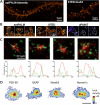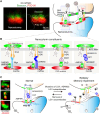Celebrating the Birthday of AMPA Receptor Nanodomains: Illuminating the Nanoscale Organization of Excitatory Synapses with 10 Nanocandles
- PMID: 38839340
- PMCID: PMC11154862
- DOI: 10.1523/JNEUROSCI.2104-23.2024
Celebrating the Birthday of AMPA Receptor Nanodomains: Illuminating the Nanoscale Organization of Excitatory Synapses with 10 Nanocandles
Abstract
A decade ago, in 2013, and over the course of 4 summer months, three separate observations were reported that each shed light independently on a new molecular organization that fundamentally reshaped our perception of excitatory synaptic transmission (Fukata et al., 2013; MacGillavry et al., 2013; Nair et al., 2013). This discovery unveiled an intricate arrangement of AMPA-type glutamate receptors and their principal scaffolding protein PSD-95, at synapses. This breakthrough was made possible, thanks to advanced super-resolution imaging techniques. It fundamentally changed our understanding of excitatory synaptic architecture and paved the way for a brand-new area of research. In this Progressions article, the primary investigators of the nanoscale organization of synapses have come together to chronicle the tale of their discovery. We recount the initial inquiry that prompted our research, the preceding studies that inspired our work, the technical obstacles that were encountered, and the breakthroughs that were made in the subsequent decade in the realm of nanoscale synaptic transmission. We review the new discoveries made possible by the democratization of super-resolution imaging techniques in the field of excitatory synaptic physiology and architecture, first by the extension to other glutamate receptors and to presynaptic proteins and then by the notion of trans-synaptic organization. After describing the organizational modifications occurring in various pathologies, we discuss briefly the latest technical developments made possible by super-resolution imaging and emerging concepts in synaptic physiology.
Copyright © 2024 the authors.
Conflict of interest statement
The authors declare no competing financial interest.
Figures





Similar articles
-
Super-resolution imaging reveals that AMPA receptors inside synapses are dynamically organized in nanodomains regulated by PSD95.J Neurosci. 2013 Aug 7;33(32):13204-24. doi: 10.1523/JNEUROSCI.2381-12.2013. J Neurosci. 2013. PMID: 23926273 Free PMC article.
-
AMPA receptor nanoscale dynamic organization and synaptic plasticities.Curr Opin Neurobiol. 2020 Aug;63:137-145. doi: 10.1016/j.conb.2020.04.003. Epub 2020 May 13. Curr Opin Neurobiol. 2020. PMID: 32416471 Review.
-
Organization and dynamics of AMPA receptors inside synapses-nano-organization of AMPA receptors and main synaptic scaffolding proteins revealed by super-resolution imaging.Curr Opin Chem Biol. 2014 Jun;20:120-6. doi: 10.1016/j.cbpa.2014.05.017. Epub 2014 Jun 27. Curr Opin Chem Biol. 2014. PMID: 24975376 Review.
-
Evidence for low GluR2 AMPA receptor subunit expression at synapses in the rat basolateral amygdala.J Neurochem. 2005 Sep;94(6):1728-38. doi: 10.1111/j.1471-4159.2005.03334.x. Epub 2005 Jul 25. J Neurochem. 2005. PMID: 16045445 Free PMC article.
-
Synapse-specific and developmentally regulated targeting of AMPA receptors by a family of MAGUK scaffolding proteins.Neuron. 2006 Oct 19;52(2):307-20. doi: 10.1016/j.neuron.2006.09.012. Neuron. 2006. PMID: 17046693
Cited by
-
Release your inhibitions: The cell biology of GABAergic postsynaptic plasticity.Curr Opin Neurobiol. 2025 Feb;90:102952. doi: 10.1016/j.conb.2024.102952. Epub 2024 Dec 25. Curr Opin Neurobiol. 2025. PMID: 39721557 Review.
-
Biochemistry and physiology of voltage-gated calcium channel trafficking: a target for gabapentinoid drugs.Open Biol. 2025 Jul;15(7):250013. doi: 10.1098/rsob.250013. Epub 2025 Jul 16. Open Biol. 2025. PMID: 40664238 Free PMC article. Review.
-
Neuronal plasticity and its role in Alzheimer's disease and Parkinson's disease.Neural Regen Res. 2026 Jan 1;21(1):107-125. doi: 10.4103/NRR.NRR-D-24-01019. Epub 2024 Dec 16. Neural Regen Res. 2026. PMID: 39688547 Free PMC article.
References
-
- Baddeley D, Crossman D, Rossberger S, Cheyne JE, Montgomery JM, Jayasinghe ID, Cremer C, Cannell MB, Soeller C (2011) 4D super-resolution microscopy with conventional fluorophores and single wavelength excitation in optically thick cells and tissues. PLoS One 6:e20645. 10.1371/journal.pone.0020645 - DOI - PMC - PubMed
Publication types
MeSH terms
Substances
LinkOut - more resources
Full Text Sources
